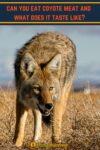Coyote meat is perfectly edible but something of an acquired taste.
Many people refuse to eat coyote because it looks so much like a domestic dog, while its reputation as a dirty animal puts others off.
I can understand why people may balk at the idea of eating coyote; after all, they eat almost anything, including whatever they find in your garbage can.
Coyotes are opportunistic omnivores with a wide-ranging diet that can include rodents, rabbits, frogs, and even insects. They also enjoy various fruits and vegetables, including berries and melons.
Unfortunately, coyotes will also feed on decomposing carcasses, a behavior that can negatively impact the flavor of their meat.
Is Coyote Meat Safe to Eat?
When cooked thoroughly, coyote meat is just as safe as any other wild meat. The cooking process destroys any nasty toxins or pathogens that might be present in the meat.
As with other wild meats, coyotes may contain a parasite called trichinella. A type of roundworm, trichinella, can cause a parasitic infection that causes abdominal pain, vomiting, diarrhea, and fever.
You can eliminate the risk of contracting trichinella by cooking coyote meat thoroughly. That means cooking it “until the juices run clear and the meat is no longer pink.”
You should use a meat thermometer to reduce the risk of food-borne disease. Coyote meat is only safe to eat once it reaches an internal temperature of around 160°F.
Coyotes are also prone to common diseases, including rabies. Although “thorough cooking will inactivate the rabies virus,” you should still avoid eating infected animals.
If you shoot an animal showing signs of illness, it’s best to discard the meat rather than risk infection by eating it. You should also be careful when handling the animal, as coming into contact with the raw meat can be risky.
Similarly, if you shoot a coyote in the abdomen, the intestinal contents can contaminate the meat, rendering it inedible.
What Does Coyote Meat Taste Like?
Coyote meat has a strong flavor and gristly texture that many people find off-putting. Others find it tastes similar to pork, while others say it tastes like a cross between chicken and venison.
The flavor of coyote meat varies seasonally due to changes in the animal’s diet. A coyote hunted in the winter will taste far nicer than one shot during the summer months.
In summer, you may need to soak coyote meat in a brine solution to tenderize and cleanse the meat. Adding antibacterial herbs like garlic and ginger also reduces bacteria buildup and enhances the flavor.
This is because the hot weather causes meat to rot faster, meaning that coyotes feed on more carrion and decomposing meat during the summer than in the winter.
Lean cuts of coyote meat are generally more flavorful as the fat can add an unpleasant, gamey flavor to the meat.
Is it Legal to Hunt and Eat Coyote?
In most states, hunting coyote all year round is legal, although usually only during daylight hours. You can hunt coyotes in many places without needing a special permit or license, although it depends on the season.
In Missouri, for instance, “coyote hunters must also possess an unfilled spring turkey hunting permit” if they want to hunt during spring turkey season, which usually runs from April 17 to May 7.
Some states offer bounties to coyote hunters, with Texas awarding up to “$5 for each wolf, coyote, panther, or bobcat” and Utah offering up to “$50 for each properly documented coyote.”
In some areas, there are restrictions on the type of weapon and ammunition that may be used to kill a coyote.
In Virginia, it’s “unlawful to hunt with a rifle larger than twenty-two one-hundredths of an inch (.22) caliber rim fire.” In Massachusetts, there is no restriction “on size or caliber of rifles or handguns” when hunting during the day, but nighttime hunters are restricted to a .22 caliber rifle.
Most people prefer to hunt coyotes in winter when the animals feed on more fresh meat and less carrion. Coyotes also have fewer parasites during the winter months, making their meat more palatable.
Is Coyote Meat Good for You?
Coyote meat has more nutritional value than many of the meats you find in the supermarket. Not only is it high in protein and low in fat, but it’s also rich in riboflavin, which our bodies need to break down fats, produce energy, and grow cells.
It’s also a good source of iron and zinc, which help deliver oxygen to your muscles and support your immune system.
How to Prepare Coyote Meat
Coyote meat is surprisingly versatile, especially if you remove the fat first. Coyote fat has an unusual chemical-like flavor and smell that can detract from the rich flavor of the meat.
Chop your coyote meat into chunks and add bacon drippings and Worcestershire to create a mouth-watering stew, or grind it into minced meat to make a firecracker chili.
If you prefer to grill your meat, you’ll first want to marinate your coyote steaks for several hours. A simple marinade using apple cider vinegar, olive oil, and seasoning draws out the flavor of the meat, especially if left overnight.
Once marinated, cook your coyote steaks gently and slowly until they reach an internal temperature of 160°F, and then serve with a spicy sauce.
You can also whip up a coyote casserole, using creamy soups and wine to combine all the flavors.
If you’re feeling particularly adventurous, you could even transform the best cuts of your coyote into jerky by marinading and drying it in a dehydrator.
Conclusion
You may only get around 15 to 18 lbs of edible meat from a single coyote, but that’s still enough for about 60 to 70 four-ounce servings. In other words, one coyote could feed a family of four for over two weeks!
Although approximately 320,000 coyotes are hunted annually, most of the meat is discarded, even though it’s perfectly safe to eat. With around 34 million Americans facing food insecurity and hunger, that’s an enormous waste.
Not only is coyote meat edible, but it’s also healthy and nutritious and could provide a sustainable food source for millions of people.
Unlike other animals that are best eaten in the spring or summer, coyote meat tastes best during the winter, offering an excellent source of protein at a time when other sources are unavailable.
You may not find coyote meat on the menu in a fancy restaurant, but it could be an essential survival food or a healthier and more sustainable alternative to beef.


